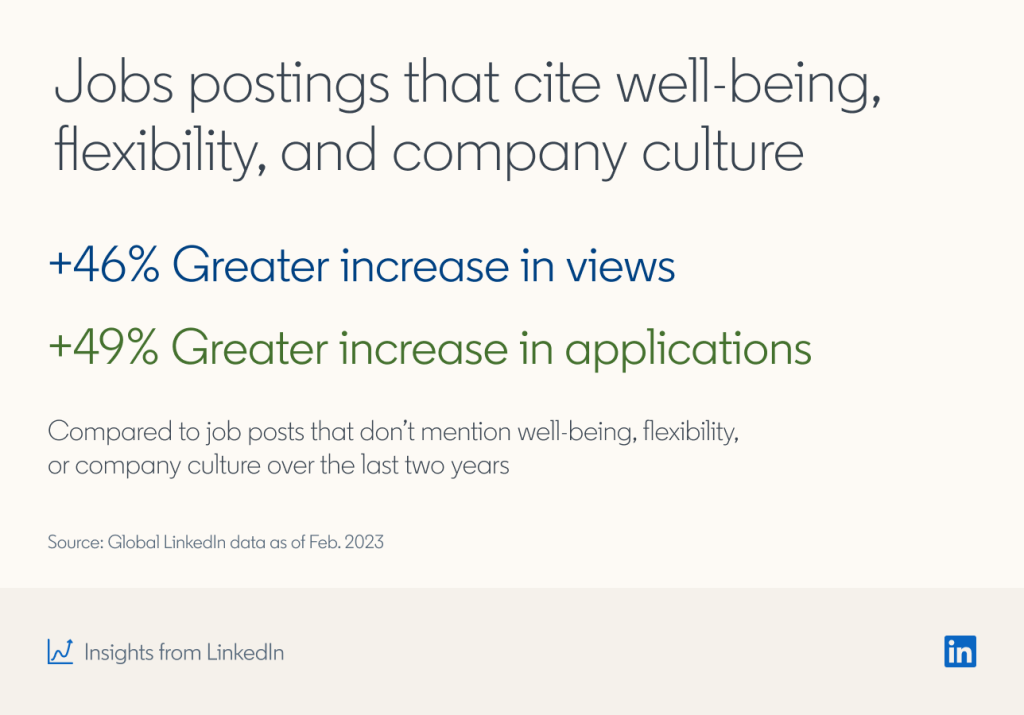Sometimes, a company’s culture can lean too far into a workaholic ethos. If you’re not working extra hours, sacrificing your personal life, and constantly running on empty, are you really working hard enough? The dangers of such a culture are clear: It encourages performative overwork, leads to burnout, and produces poor results.
Jen Fisher, Deloitte’s chief well-being officer, said as much in LinkedIn’s 2022 Global Talent Trends report on the reinvention of company culture. “In the workplace, we shouldn’t value or celebrate the people who stay up all night and burn the midnight oil,” Jen said, “that doesn’t really produce great results for that person or the organization.”
Now, new LinkedIn data suggests that candidates agree with that approach — and actually gravitate toward the employers who value and celebrate well-being, flexibility, and company culture.
Job posts that mention well-being, flexibility, or company culture are getting more views and applications
Compared with two years ago, paid job postings on LinkedIn that mention well-being, flexibility, or culture now receive nearly three times (+175%) more views and more than twice (+139%) as many applications.
It’s important to note that views and applications are up overall across all job posts, reflecting broader macroeconomic changes. So, how do we know that the increases cited above aren’t just part of a larger trend? Because we looked at the growth of these particular job posts and compared it with overall growth.

Indeed, LinkedIn’s data reveals that over the past two years, job posts mentioning well-being, flexibility, or culture have seen their views grow by 46% more and applications grow by 49% more, compared with the growth of job posts that don’t mention them.
Put simply: Job posts that include these employee priorities are seeing a sharp increase in candidate engagement — and that growth is clearly outpacing the increase seen in job posts that neglect to mention them.
Don’t tout well-being, flexibility, and culture unless your company actually delivers on them
If you can authentically advertise your company’s commitment to well-being, flexibility, or culture in your job posts, you should strongly consider doing so. LinkedIn data suggests these employee priorities really resonate with candidates.
That said, don’t assume you can slap a few buzzwords like “well-being” and “flexibility” into your job posts if your company culture doesn’t actually deliver on them. What’s more, your company culture shouldn’t displace other critical information from your job post, like the day-to-day responsibilities and salary range.
As a talent professional, you can leverage these insights to craft more compelling job posts that showcase your employer brand and attract more qualified applicants. For another simple way to showcase what your company values, you can now add Commitments, such as “work-life balance” or “social impact,” to your LinkedIn Company Page. See this guide on Commitments for more detailed best practices.
By highlighting how your company supports well-being, flexibility, and culture, you can stand out from the competition and win over the talent you need.
Methodology
This analysis is based on global LinkedIn data from March 2021 to February 2023, and only considers paid job postings published on LinkedIn. Keyword analysis was used to identify job posts that mention well-being, flexibility, or culture. Categories included similar terms (e.g., flexibility included “remote work” and “work from home” as keywords) and were translated into Spanish, French, Japanese, Dutch, Italian, German, Portuguese, Turkish, and Chinese. Keywords were then used to classify content for comparative analyses
...
This article was originally posted on LinkedIn





